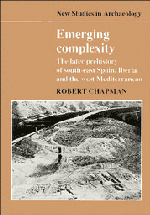Book contents
- Frontmatter
- Contents
- List of figures
- List of tables
- Preface
- 1 Two tribes: questions of theory, scale and explanation
- 2 Hello, goodbye: Iberian prehistory and traditional archaeology
- 3 Another one bites the dust: the implications of the absolute chronology
- 4 Getting better: south-east Spain, the cultural framework 5000–500 bc
- 5 Dancin' in the dark? Adaptation and intensification in south–east Spain
- 6 Centrefield: recent models of intensification and cultural change in south-east Spain
- 7 Into the groove: system scale and technological innovation in south-east Spain
- 8 Out of reach? Complexity, interaction and integration in south-east Spain
- 9 Eliminator: models and the archaeological record in south-east Spain
- 10 Strong persuader: intensification and interaction in Iberia and the west Mediterranean
- 11 With or without you: variability, evaluation and complexity
- Bibliography
- Index
5 - Dancin' in the dark? Adaptation and intensification in south–east Spain
Published online by Cambridge University Press: 05 March 2012
- Frontmatter
- Contents
- List of figures
- List of tables
- Preface
- 1 Two tribes: questions of theory, scale and explanation
- 2 Hello, goodbye: Iberian prehistory and traditional archaeology
- 3 Another one bites the dust: the implications of the absolute chronology
- 4 Getting better: south-east Spain, the cultural framework 5000–500 bc
- 5 Dancin' in the dark? Adaptation and intensification in south–east Spain
- 6 Centrefield: recent models of intensification and cultural change in south-east Spain
- 7 Into the groove: system scale and technological innovation in south-east Spain
- 8 Out of reach? Complexity, interaction and integration in south-east Spain
- 9 Eliminator: models and the archaeological record in south-east Spain
- 10 Strong persuader: intensification and interaction in Iberia and the west Mediterranean
- 11 With or without you: variability, evaluation and complexity
- Bibliography
- Index
Summary
I have chosen to begin my discussion of processes leading to cultural change in southeast Spain with intensification for two main reasons. First we have already seen in chapter 1 that intensification of production is a variable which has received much attention in archaeology and anthropology in the debate about the origins of cultural complexity. Was it a cause or a consequence of population growth? Did it promote management or conflict? Was it a response to environmental stress or an independent, socially motivated strategy? Given this wide concern, and the extensive discussion intensification has received in Aegean archaeology, it is an obvious starting-point for any comparative study of complexity.
Secondly, intensification of production has already been identified by archaeologists working in Iberia as a critical variable in the emergence of Copper and Bronze Age cultures (e.g. Chapman 1975, 1978; Gilman 1976, 1981; Gilman and Thornes 1985; Lull 1983, 1984; Mathers 1984a; Ramos 1981; Harrison 1985). Opinions differ as to the stimulus leading to this intensification, the precise form it took and its social consequences. In some cases the models proposed are statements of faith and have yet to be subjected to testing. In this context a clear evaluation of the existing data, and their limitations, is required. What was the nature and scale of local intensification? How does the evidence for this intensification process correlate in time and space with that for changes in culture, society and population?
- Type
- Chapter
- Information
- Emerging ComplexityThe Later Prehistory of South-East Spain, Iberia and the West Mediterranean, pp. 97 - 140Publisher: Cambridge University PressPrint publication year: 1990



